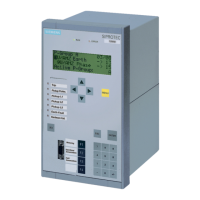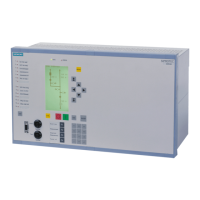•
Connection of the U
4
input to the open delta winding Ue–n of the voltage transformer set:
Address 210 is then set to: U4 transformer = Udelta transf..
When connected to the e-n winding of a set of voltage transformers, the voltage transformation ratio of
the voltage transformers is usually:
The factor Uph/Udelta (secondary voltage, address 211 Uph / Udelta) must be set to 3/√3 = √3 ≈ 1.73.
For other transformation ratios, e.g. the formation of the displacement voltage via an interconnected
transformer set, the factor must be corrected accordingly. This factor is important for monitoring the
measured values and the scaling of the measured values and fault recording values.
•
Connection of the U
4
input to perform the synchronism check:
Address 210 is then set to: U4 transformer = Usy2 transf..
If the voltage transformers for the protection functions U
sy1
are located on the outgoing feeder side, the
U
4
transformer has to be connected to a busbar voltage U
sy2
. Synchronisation is also possible if the
voltage transformers for the protection functions U
sy1
are connected on busbar side, in which case the
additional U
4
transformer must be connected to a feeder voltage.
If the transformation ratio differs, this can be adapted with the setting in address 215 Usy1/Usy2
ratio. In address 212 Usy2 connection, the type of voltage connected to measuring point U
sy2
for
synchronism check is set. The device then automatically selects the voltage at measuring point U
sy1
. If the
two measuring points used for synchronism check — e.g. feeder voltage transformer and busbar voltage
transformer — are not separated by devices that cause a relative phase shift, then the parameter in
address 214 φ Usy2-Usy1 is not required. This parameter can only be changed in DIGSI at Display Addi-
tional Settings. If, however, a power transformer is connected in between, its vector group must be
adapted. The phase angle from U
sy1
1 to U
sy2
is evaluated with positive sense.
Example: (see also Figure 2-4)
Busbar 400 kV primary, 110 V secondary,
Feeder 220 kV primary, 100 V secondary,
Transformator 400 kV / 220 kV, vector group Dy(n) 5
The transformer vector group is defined from the high voltage side to the low voltage side. In this
example, the feeder transformers are those of the low voltage side of the transformer. Since the device
“looks” from the direction of the feeder transformers, the angle is 5 · 30° (according to the vector group)
negative, i.e. - 150°. A positive angle is obtained by adding 360°: Address 214: ϕ Usy2-Usy1 = 360° - 150°
= 210°.
Adresse 214: φ Usy2-Usy1 = 360° - 150° = 210°.
The busbar transformers supply 110 V secondary for primary operation at nominal value while the feeder
transformers supply 100 V secondary. Therefore, this difference must be balanced:
Address 215: Usy1/Usy2 ratio = 100 V/110 V = 0,91.
Functions
2.1 General
SIPROTEC 4, 7VK61, Manual 33
C53000-G1176-C159-5, Edition 05.2018

